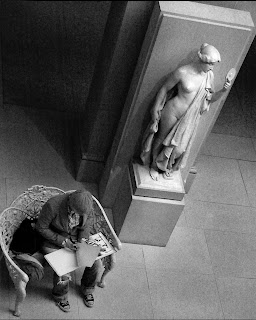0176
With a lot of music AI, I just put it on in the background and see if anything grabs me. From my emulation days in the 70s, the desire to play music was driven by the desire to sound like someone else, but I haven't had this experience with AI music, which tends to be more of a chore weeding through the permutations. I liked the "Daddy's Car" piece which came out about five years ago. I thought it had a "cubist" vibe to it. (In general, I'm primed to look for something that looks as new as Cubism looked 100 years ago).
***
"The most important philosophical question to settle is simply whether or not whole brain emulation for humans preserves personal identity. The whole brain emulation has three stages: mapping, simulation, and embodiment. Because we are talking about a human being, rather than a mouse, the emulation's behavior should be close enough to that of the original subject to convince his or her friends and relations. To qualify as behaviorally indistinguishable, the emulation should walk and talk just like the original, recalling the same shared experiences and exhibiting the same personality traits, whether lovable or annoying. The question then is whether the emulation would be the same person, that is to say, whether their personal identity would survive the procedure." Shanahan, Murray. The Technological Singularity. United Kingdom, MIT Press, 2015. (199)
***
How algorithms are the next Roger Waters. Algorithms are the like a Roger Waters or a Pete Townshend in terms of creating conceptual frameworks for music. If a songwriter or composer has lots of material, AI could be used to gather pre-existing idea snippets based on certain attributes. AIs might be good conceptualizers. What's more interesting is that the playlist also becomes the seed for new material, then gets folded back into more conceptual music, which is then sorted again, for endless conceptual music without flipping the vinyl over or changing the record. ("“The feedback mechanisms are reiterating a certain homogeneity of consumption.”) Composers may want this as a constraint for creativity, because you are winnowing the possibilities as you move towards a resolution of something. Moreover, using the streaming metaphor would allow us to see music as going down to the riverside to commune with nature and enjoy whatever is floating past, without having to choose an artist or a title. But all of this is extremely passive, and is "hot" in the McCluhan sense because we can't interact or manipulate it. A part of the creative process is emulation and mimicry, but will we want to mimic AI?
***
In his interview on the On Being podcast, composer Gustavo Santaolalla talked about how young tango musicians are very good technically, but lack knowledge of the deeper personal and cultural meanings in the art form. This should be no surprise given we learn through emulation and imitation, primarily through recordings instead of teachers and mentors. It poses an interesting facet of emulation that demotes direct experience over copying and remixing.
Once you've taken note of something, it's easier to recognize. Emulation in art and music works on this principle, and is hugely powerful in the development of a signature vision or style. Most of the time we don't recall where we've seen or heard something, yet subtly influences what we do--sometimes for our entire lives.
***
Once a style is established, it creates a feedback loop where you don’t know if it is culture that makes style or vice versa. Back in the mid-1960s when psychedelia was a virulent cultural epidemic, emulation was the primary method of its rapid proliferation. As the manager of the band Pink Floyd, Peter Jenner explains, “We thought we were doing what was happening on the West Coast – which we never heard. And it was totally different. Attempting to imitate when you don’t actually know what you’re imitating leads to genuine creativity, and that’s what happened with the Floyd.”
***
The flip-side of emulation: copyright claims, most notably the protracted litigation of Stairway to Heaven, claimed to be a ripoff of Spirit's Taurus.
There's nothing particularly unique about Taurus. The chord sequence in both songs use standard functional harmony, with a descending bass line emerging form chord inversions--a sound baked into western music. In essence, they are "folk memories".
Very often works are created seemingly as unique objects, when if fact they are created in a 'delayed borrowing' where just enough time has passed between seeing or hearing something and making something inspired by it, that the artist believes that it is a unique singular event, that they came up with it.
Andy Warhol's Sleep film (1963) was believed to have been inspired by the performance of Erik Satie's Vexations (1893) which consisted of playing a short piano theme 840 times, performed in a series of relays. But it is not certain that Warhol was even at that performance.
John Cage:
"In September, 1963, we had ten pianists to play one of Satie's Vexations in relays, including me and one music critic who thought he could play the piece and wanted to get in the act... I hadn't realized that Andy was there. But even if he wasn't, it doesn't surprise me that his work followed the same lines. Of course, artists are encouraged by other things that happen, but mostly by what is either in the air or already inside them.
Another example of a folk memory:
The first drafts of David Bowie's Space Oddity were apparently inspired by the Bee Gee's first hit New York Mining Disaster 1941.
More often than not the copy improves the original, removing the rough edges in the first version, and making the ideas stronger. (If artists don't do preliminary studies of new works, society may in fact do it for them, and that's where emulation is taking place, and is probably done unwittingly as a folk memory).

